How to make a charcoal filter for an aquarium. DIY aquarium filter
Every aquarium should have a filtration system that will purify the water, keeping fish and plants healthy. As you know, the waste that the inhabitants of the reservoir leave behind, as well as the remnants of food, suspended particles of soil, are very harmful to fish. Food that is not eaten is oxidized to toxic ammonia. In order for the water to go through all the cleaning steps in a timely manner, it is better to make an external filter for the aquarium with your own hands. It will prevent the appearance of harmful substances that can poison living beings.
Quick jump to the article
How do I design an external filter?
Before making an aquarium filter with your own hands, you should understand how the filtration system works. Biological filtration in an aquarium is the process by which ammonium is converted to nitrite, then to nitrate. Biofiltration is carried out thanks to beneficial microorganisms that live in aquatic environment. This process depends on the amount of oxygen absorbed, therefore it is important to maintain a constant supply of aeration in the tank using a filter and compressor.
See how a homemade external filter made from plastic bottles works.
To make an external biological filter with your own hands, you should prepare the following materials:
- Plastic bottle from under mineral water volume of 0.5 l;
- A plastic tube with the diameter of the neck of this bottle;
- Sintepon;
- Compressor and hose to it;
- Aquarium pebbles up to 5 mm in diameter.
The plastic bottle must be divided into 2 parts so that fragments are obtained from it. different sizes... You should get a cup with a neck and a big bottom. The bowl should be directed with the neck side up and fit snugly into the bottom. In the outer circle of the bowl, you need to make several openings through which water can enter the filter. The recommended diameter of the openings is 3-4 mm, their arrangement is in 2 rows, with 4-6 holes in each.


Next, the tube should be inserted into the neck of the bowl so that it fits tightly into it. After the procedure, you should not notice any gaps or holes between the tube and the neck. The length of the tube itself is selected taking into account the protrusion above the structure by 2-3 cm. Moreover, it should not touch the bottom of the bottle. If the step is not performed correctly, water will not be able to flow into the mechanism.
Take gravel and sprinkle it on top of the bowl with a layer of 6 cm, and cover it with a piece of padding polyester. Install the hose from the aerator in the tube, and fix it. When the mechanism is ready, it needs to be placed in the aquarium. The compressor must then be turned on in order for the filter to begin its work. In the operating equipment, beneficial microorganisms will appear that will process ammonia into nitrates, which forms a useful microbiological environment in the water.
How does a handcrafted external filter work?
A home-made external filter is designed on the basis of aero-lifting: air bubbles that come from the compressor rise to the tube from which they come up and lower the water flow from the filter along with them. Clean and oxygenated water enters the upper section of the glass and passes through the gravel. Then the water enters the bowl through the hole, goes down the tube, and enters the tank. The synthetic winterizer here functions as a mechanical filter. This material prevents the process of siltation of the gravel substrate.
Chemically and mechanically purifies water. It is better to install such structures in a large aquarium with a volume of 200-400 liters. Larger aquariums with a capacity of 500-1000 liters will require several of these devices. Branded external systems water purification is expensive, so it's best to do it yourself. Materials are inexpensive and affordable for everyone.

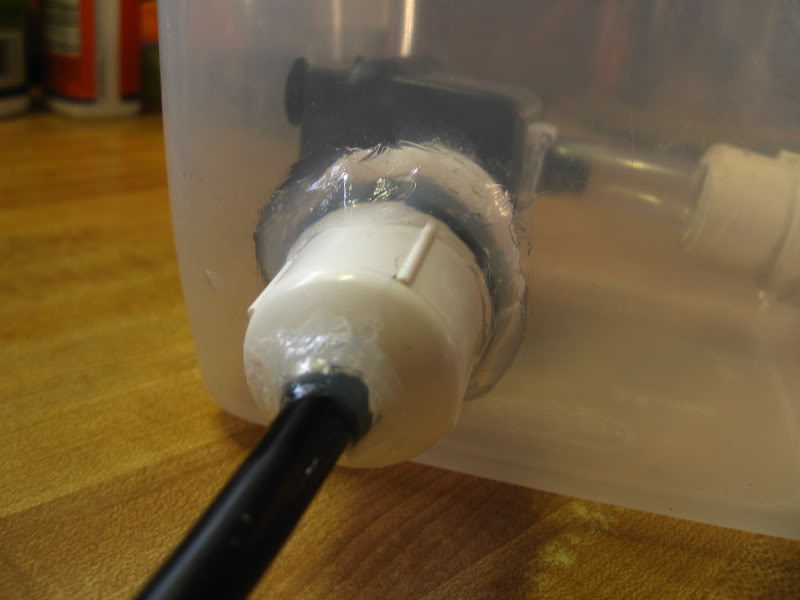

Another way to make an external filter
For the next external filter, you need to prepare the following parts:
- Plastic container with a tight-fitting lid (you can take a box for storing cereals);
- Sponge or thick porous material;
- Sealed water pump and fitting for attachment to the container lid;
- Material for biological filtration(medical cotton, ceramic granules);
- Multiple suction cups, resin adhesive texture.
See how to make an external filter yourself.
Filter making instructions:
- You need to take a thin file and make cuts around the entire perimeter of the lower compartment of the plastic container. The incisions will allow water to pass through.
- In that Plastic container put a sponge, on it - cotton wool or other element for biofiltration.
- Make holes on the container lid that will match the diameter of the pump connection.
- Insert the nipple into the hole you made and secure it with resin or aquarium silicone.
- A pump should be screwed onto the fitting, which can create pressure inside the container.
- On the wider side of the container, attach several household suction cups.
- The internal filtration system can be considered complete. The suction cups will be able to hold the device on the wall of the aquarium.
Such a homemade filter can be mounted not on the wall, but placed on the ground of the tank. The soil will also act as a biological filter. A nozzle made of plastic in the form of a long tube extending outward can be attached to the outlet of the sediment. Then, after purification, the water will be saturated with oxygen.
Instead of a small plastic container, you can use plastic canister or a canister made of stainless, non-toxic metal. This design is suitable for large aquariums; large cassettes and cartridges with filtration elements can be placed in it. Homemade filters need to be serviced at the same frequency as branded ones.
If the filter leaks, then check all its elements:
- The clamps of the mechanism are tightly closed. You may have inadvertently secured the parts with glue or resin. You can solve the problem by re-fastening the clamps.
- The sponge or suction cup may become dirty in the filter while it is running. Slime and debris can be cleaned off with water. Check the construction for cleanliness monthly.
- Damage to the plastic container, which will have to be replaced by redoing the filter itself.
Novice amateur aquarists, as a rule, buy small aquariums and very quickly become convinced that they do not grow well in such aquariums, adult fish feel uncomfortable, and the water height is low for plants. Such aquariums have to be changed to other, more voluminous ones. In large aquariums, the population grows evenly, and more and more often it is necessary to clean the aquarium of the accumulated dirt.
As a rule, to maintain the cleanliness of the aquarium, various mud scoops are used, regularly remove dirt from the bottom with a hose, and also use special filters... By using filter you can cleanse the water in the aquarium from dirt particles (turbidity,) and at the same time saturate the water with oxygen, which is necessary for the respiration of fish and other aquatic life.
As needed, activated carbon is placed in the filters, which sucks dissolved harmful substances, peat for water acidification, various pharmaceuticals that can have a beneficial effect on the inhabitants of the aquarium.
Filter designs
Filters are functionally subdivided into internal and external.
The designs of the internal filters are ordinary. They are usually small in size and low in performance. They function with a microcompressor that supplies air through a tube. Air bubbles rising in the tube capture water and raise it above the water level in the aquarium. The generated water flow passes through the filter material and thus the aquarium is cleared of dirt. Such filters, in accordance with the mechanism of operation, are called airlift.
External Filters most often used for large aquariums. They are driven by an electric pump that drives the aquarium water through the filter material in the filter housing. These filters are complex, relatively large and are installed next to the aquarium or hung on its wall.
The performance of the filters, in other words the volume of water that passes through in a certain stage of time, depends on the volume of air transmitted by the compressor, as well as the size of the filter. Internal filters put on the ground (day), wall and under the soil of the aquarium. When feeding the inhabitants of the aquarium, it is better not to supply air, so that the food does not get into the filter and does not decompose inside it. The filter must be frequently cleaned of dirt so that harmful bacteria do not grow in it.
In the form of a filtering material, fine or coarse quartz river sand (pre-washed and boiled) is used, as well as synthetic fabric and threads (nylon, nylon, and others). Also, waterproof foam rubber is used as a filtering material, in large pores of which dirt accumulates well.
Aquarists can be offered several options for very simple, but very effective internal airlift filters, which are used to purify water in aquariums with a volume of up to 100 liters. They can be easily done do it yourself from scrap materials.

A box with a tight-fitting lid can be used as a filter housing. To do this, you need to find a ready-made box (made of plastic). You can use a cut-off plastic bottle or glue it with organic glass.
In order to be able to observe the accumulation of dirt in the filter and to timely clean the filter material from it, it is better that the filter housing or cover is made of transparent material. A plastic tube with a diameter of 15-20 mm and a length of 150-200 mm is tightly inserted or glued into the housing cover. The air atomizer should be used with a ceramic commercially available one. A number of holes of such a diameter are made in the side wall of the body so that snails or fry cannot get through them into the inside of the filter. The filter housing is not filled too tightly with the filter material. It should be noted that the effectiveness of the filter largely depends on the operation of the atomizer, since than smaller size s of air bubbles, the larger their total surface, which is in contact with water, in other words, the water is much better saturated with oxygen in the air, therefore, the flow of water through the filter material increases.
Another internal filter can be do it yourself... A standard filter is used as the filter housing. glass jar with a capacity from 0.4 to 1 liter. Its body is closed with a regular polyethylene lid, in which holes are made for the supply of aquarium water, as well as a hole for installing a tube. A partition is made of a similar cover (filter material is settled between the partition cover).
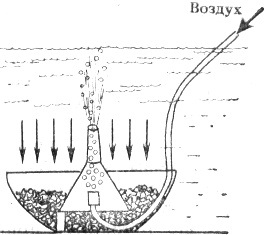
Does not require a lot of time for assembly and the next filter. Its body is an earthen bowl, in which an ordinary funnel is installed on the filtering material. To prevent the funnel from going deep into the filter material, lining is placed under its edges. The filter is made two-layer of quartz sand and nylon threads. Sand should be used medium-grained with a grain size of 1.5 - 2 mm. The air atomizer, as in the manufacture of other models, should be used ready-made, purchased in the store.
DIY aquarium filter., 3.6 out of 5 based on 26 ratingsNovice amateur aquarists usually buy small aquariums and very soon become convinced that fry do not grow well in such aquariums, adult fish feel uncomfortable and the water height is low for plants. We have to replace such aquariums with other, large ones. But in large aquariums, the population gradually grows, and more and more often it becomes necessary to clean the aquarium of accumulating dirt.
Usually, to maintain cleanliness in the aquarium, they use various mud scoops, systematically remove dirt from the ground (bottom) with a hose, and use special filters. By the way, with the help of a filter, you can cleanse the water from particles of dirt (turbidity), while simultaneously saturating the water with atmospheric oxygen, which is necessary for breathing for fish and other aquatic animals.
If necessary, activated carbon is placed in the filters, which absorbs harmful substances dissolved in water, peat to acidify the water, medicines that have a beneficial effect on the inhabitants of the aquarium.
Filter designs.
Structurally, filters are divided into external and internal. External filters are more commonly used for large aquariums. They work with the help of an electric pump that drives water from the aquarium through the filter material in the filter housing. These filters are relatively large, complex and can be installed next to the aquarium or hung on the wall.
Internal filter designs are simple, such filters usually have small size and performance. They work with a microcompressor that supplies air to the tube. Air bubbles floating in the tube carry the water with them, raising it above the water level in the aquarium. The generated water flow passes through the filter material and is cleaned of dirt. Such filters, in accordance with the principle of operation, are called airlift filters.
The performance of the filters, that is, the volume of water passing through the filter over a certain period of time, depends on the volume of air supplied by the compressor and the size of the filter. Internal filters are installed at the bottom (ground), wall and under the ground of the aquarium. It is advisable to shut off the air supply during feeding so that the feed does not enter the filter and begin to rot. The filter must be regularly cleaned of dirt to prevent the growth of harmful bacteria.
Small and large river quartz is used as filtering materials: sand (washed and boiled), synthetic threads and fabric (nylon, nylon, etc.). Waterproof foam rubber is also used as a filter material, in the large pores of which dirt accumulates. We offer amateurs several options for very simple, but quite effective internal airlift filters, suitable for water purification in aquariums with a capacity of up to 100 liters. Which can be made "on hastily»From scrap materials.
Bottom filter housing (fig. 1) serves as a box with a tight-fitting lid. You can find a ready-made box (made of plastic), you can use a cut-off plastic bottle or glue it from organic glass with a thickness of 1.5-2 mm.
Rice. 1 Bottom filter with plastic box housing.
To monitor the content of dirt in the filter in order to timely clean the filter material from it, it is desirable that the filter housing or cover is made of transparent material. A plastic tube with a diameter of 15–20 mm and a length of 150–200 mm is glued or tightly inserted into the housing cover.
Air atomizer - purchased ceramic. A number of holes of such a diameter are drilled in the side wall of the body so that fry or snails cannot enter the filter through them. It is recommended to fill the filter housing not very tightly with the filter material. Note that the efficiency of the filter largely depends on the operation of the sprayer.
After all, the smaller the size of the air bubbles, the larger their total surface in contact with water, that is, the water is better saturated with atmospheric oxygen and the flow of water through the filter material increases.
Another simple internal filter is shown in rice. 2. Filter housing - a standard glass jar with a capacity of 0.4 - 1 liter. The body is closed with a regular polyethylene lid, in which holes are drilled for the supply of aquarium water and a hole for installing the tube. A partition is usually made of the same cover (filter material is placed between the partition cover).
Rice. 2 Bottom filter with glass jar body.
No time-consuming assembly rice. 3. The filter housing is a ceramic bowl, where an ordinary funnel is placed on the filter material. To prevent the funnel from sinking into the filter material, linings are placed under the edges of it. The filter consists of two layers: nylon threads and quartz sand with sand grains of average size 1.5 - 2 mm.
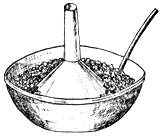

Rice. 3 Simple bottom filter.
For aquarium average size(100-200 l) an air-lift hinged filter is suitable (fig. 4).
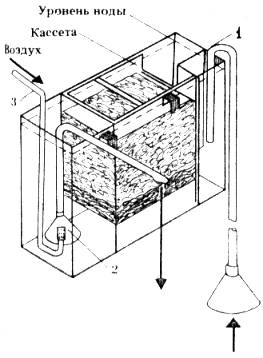
Rice. 4 Hinged filter with insert cassette: 1 - overflow tube for raising water; 2- a tube for raising water; 3- tube for air supply.
This type of filter can be hung on the side wall, inside or outside the aquarium, but so that the water levels in the aquarium and the filter match. The filter consists of a housing with a plug-in cassette in which the filter material is placed.
To clean the filter material, the cassette is removed, and the filter housing remains in place, which is very convenient. The manufacture of such a filter begins with the body. (fig. 5), and then a cassette is assembled under its dimensions (fig. 6).
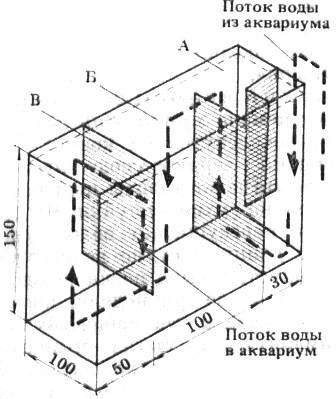
Rice. 5 Diagram of water movement in the hinged filter: A, B, C - compartments through which the water to be purified sequentially passes.
The gaps between the case and the cassette should be minimal so that the current of water passes through the cassette and does not seep through the gaps. The body and the cassette are made of transparent plexiglas 2-3 mm thick. The parts are glued with chloroform glue with dissolved plexiglass shavings or crumbs, as well as with BF-2, "Mars" glue. It is undesirable to use dichloroethane - it is very poisonous.
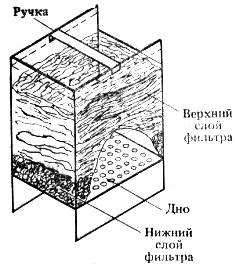
Rice. 6 The device of a plug-in cassette of the known filter.
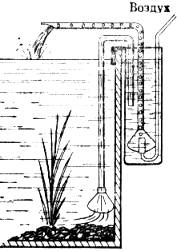
Rice. 7 Hinged filter mounted on the wall of the aquarium.
Tubes (overflow 1 and for raising water 2) can be either glass or plastic. At the lower end of the overflow tube, located in the aquarium, a cone with a mesh is reinforced (the cone will fit from a small watering can) so that the inhabitants of the aquarium would not get into the filter with a stream of water (see Fig. 4). At tube 2, the lower end should have the form of a funnel, into which air enters through the atomizer.
The diameter of the opening of the tube 3 for air supply is 3-4 mm. An air atomizer is connected to it using a piece of red rubber tube (black rubber is poisonous!). Compartment B of the filter housing is covered with a plexiglass plate with holes for fastening tubes 2 and 3 (on rice. 4 not shown). Upper layer filtering material for the initial purification of water from large particles of dirt (made from nylon or nylon threads, scraps of fabric, old stockings).
To purify water from turbidity, a layer of washed and boiled quartz is placed on the bottom of the cassette. river sand with a grain size of 1-2 mm. To activate the filter, the U-shaped tube 1 is poured with water, the holes of the tube are closed with your fingers and the tube is installed with one end in the aquarium and the other in the filter housing.
As a result, the water from the aquarium will begin to fill the filter, and after a while the water in the aquarium and in the filter will be at the same level. In order for the filter to start working, air should be supplied through tube 3. The water coming from the aquarium to the filter first goes into compartment A, then through the partition into the cassette (compartment B), where it passes through the filtering materials, is cleaned and passes under the partition into compartment C ...
From here the water rises by the elift through tube 2 and, purified and saturated with oxygen, is poured into the aquarium. The filter materials should be rinsed systematically with warm water.
In fig. 7 shows a hinged filter mounted on the wall of the aquarium.
Aquarists, especially beginners, are bound to face the challenge of water filtration. The aquarium is a living organism, and if it is left to chance, it will die. The most effective filter is a sand filter. How grains of sand manage to destroy harmful substances-metabolites and leave them necessary for the life of fish and plants is not known for certain. Usually, the sand filter is made remote, that is, they determine a place for it outside the aquarium. Schematic diagram his work looks like this:
Water from the aquarium is pumped using a special pump or airlift. In an airlift, air bubbles from a compressor serve as a vehicle for water. Making such a filter is a laborious process and not everyone can do it. But, as practice shows, the problem has a solution and the effect is quite acceptable. The schematic diagram of a simplified filter looks like this:
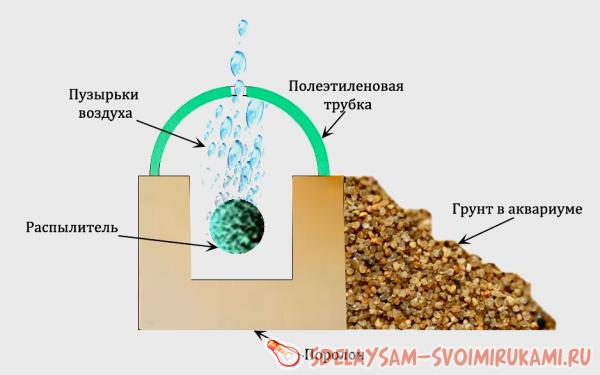
Such a filter is good in that it constantly pumps water through the soil in the aquarium and does not allow it to silt. This is very beneficial for plants.
Now, after a short theoretical introduction, let's get down to business.
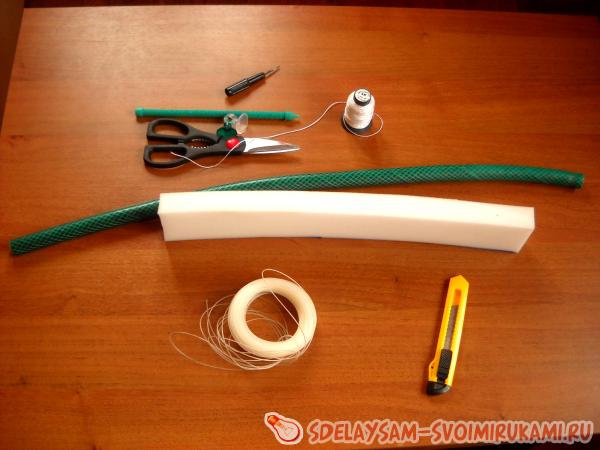
There are three main things you need to make a filter:
- not very dense foam rubber;
- a piece of PVC garden hose;
- tubular aquarium sprayers.
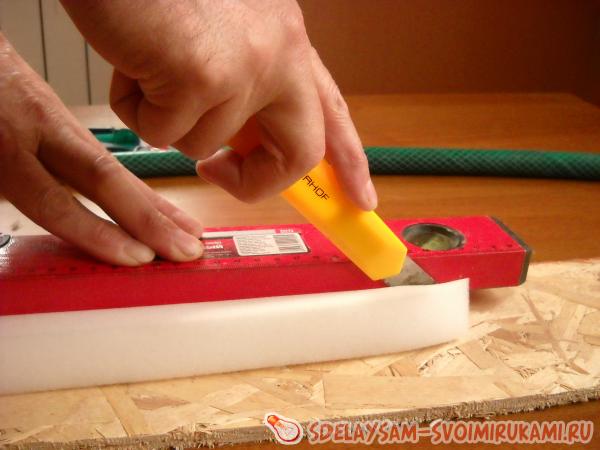
We cut out a strip of foam rubber measuring 3x3x45 cm.The length can be different and depends on the size of the nozzles and overall design aquarium. And the section length x width should be 1.5-2 cm more than the diameter of the hose.
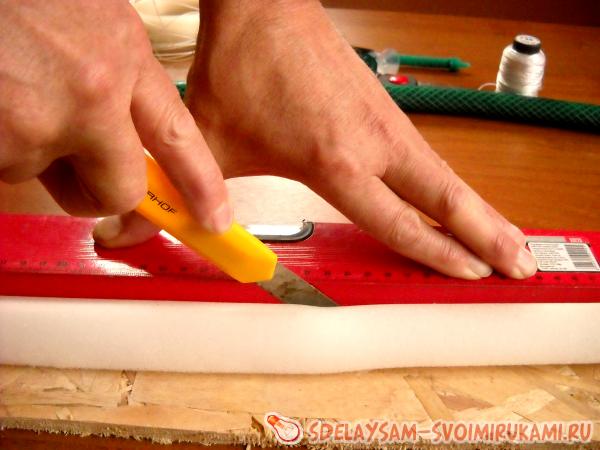
In a strip of foam rubber, cut a groove for the sprayers. We make incisions to a depth of 1-1.5 cm.
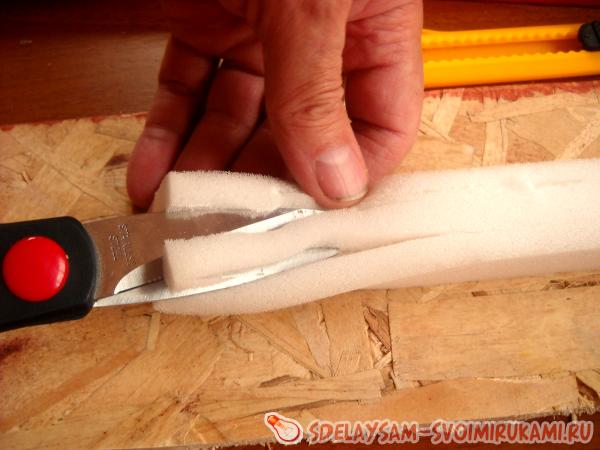
It is convenient to cut the foam rubber from the groove with ordinary scissors.
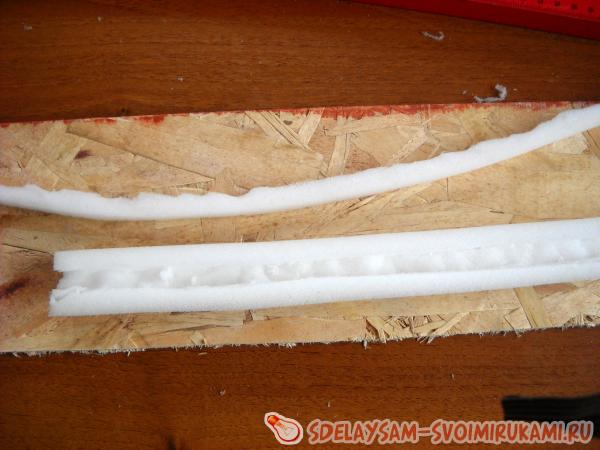
As a result, you should get such a blank. In the future, sprayers will take their place in the groove.
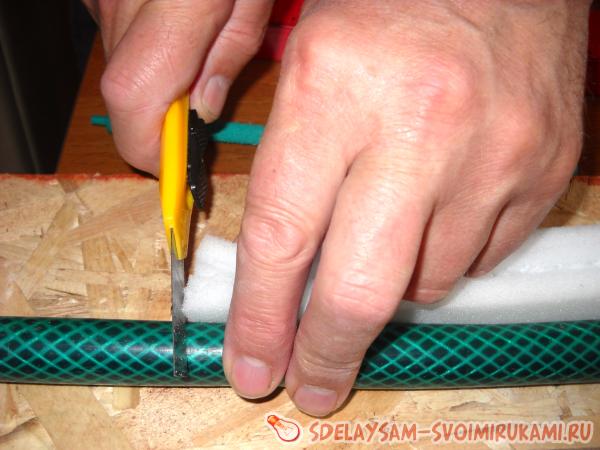
Now, according to the size of the foam blank, we will cut off a piece of the garden hose.
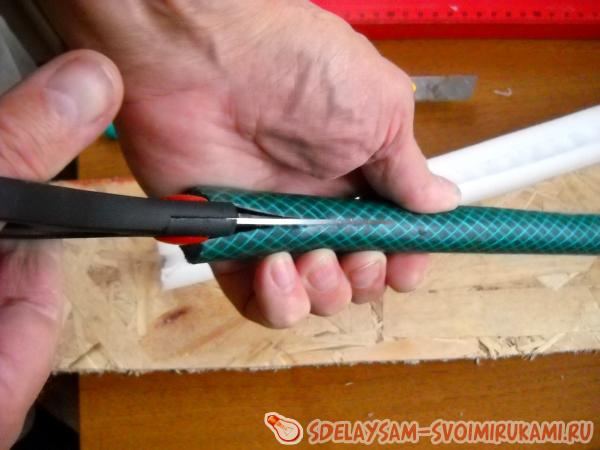
We cut the hose along its entire length. Do this conveniently and safely with scissors.

The top of the filter can be decorated with aquarium soil. The soil (coarse sand) will be the main element of the biofilter. Over time, bacteria will settle on the edges of the grains of sand. These bacteria feed on metabolites that are harmful to fish and plants. Thus, the biological balance of the reservoir will be maintained for a long time. In small aquariums, filters of this design work perfectly and do not spoil the landscape, since they are practically invisible. Air bubbles create a fabulous screen in the background, which makes the whole picture underwater world only wins.
No experienced aquarist would dare to breed fish without necessary equipment for arranging an aquarium. And a special role here is played by the filter, which is used for mechanical and biological purification of water, as well as for enriching it with oxygen.
Today, a large selection of filters is presented on the shelves of pet stores. You can buy both internal compact filters for small aquariums, and external ones for installation outside and purifying large volumes of water.
But it is not at all necessary to buy an expensive device, you can make it on your own. The parts required will depend on the type of filter as well as the size of the aquarium.
And if you're wondering, how to make a silent filter for an aquarium yourself, this article is for you.
Consider one of the options making a homemade external filter for the aquarium.
The scheme of the structure is as follows:
- the filter takes a cylindrical shape, the device will be positioned vertically,
- an electric pump is responsible for the movement of water, which must be installed at the top of the structure,
- water flows from the bottom of the structure through the fillers, and then flows back into the aquarium,
- filter materials - possible different variants fillers.
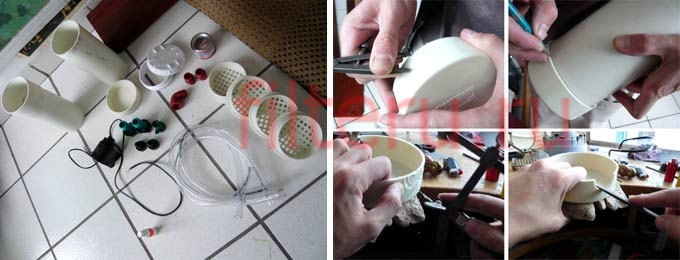
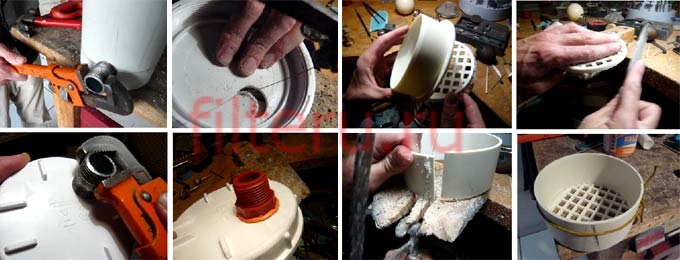
To manufacture the device you will need:
- two joining plastic pipes with a rubber cuff inside,
- two plugs for pipe ends,
- fitting,
- tap,
- electric pump,
- nuts,
- FUM tape,
- wrenches in a set.
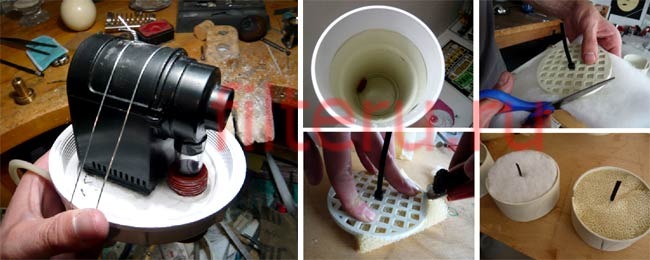
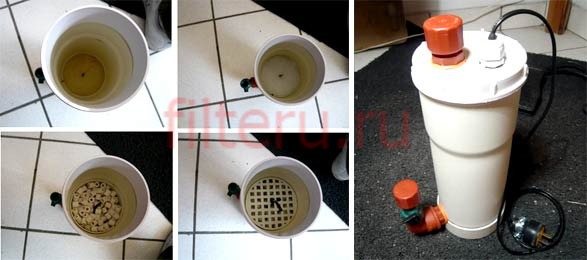
The following materials can act as filter fillers:
Polyester and foam rubber elements: the cheapest and most affordable. They can take any form, and also serve as a biological and mechanical filter. There is enough room in the pores for bacteria to settle. Periodically, the material must be washed from clogged mucus.
Also, sludge particles will be retained in the pores; in no case should it penetrate into the filter and interfere with its operation.
- Ceramic rings: used for uniform distribution water streams that will provide oxygen delivery to bacteria
- Bioballs: plastic material that rolls in water and helps to evenly wash all filter materials. In addition, it is a good substrate for bacteria colonization.
- Sintered glass: convenient to use in the form of balls up to 14 mm in diameter. Thanks to a special baking technology, the balls acquire pores, in which beneficial bacteria that process nitrates and nitrites are actively colonized. The efficiency of sintered glass is significantly higher than that of other biological treatment materials.
- Zeolite: a cheap but very effective sorbent that quickly absorbs ammonium from water. Allows you to quickly get rid of nitrates in the aquarium.
- Activated carbon: The need to use this filler is still debated. For use in aquariums, only charcoal with small granules is suitable, while the number of pores is important, because the absorption efficiency depends on this indicator. Also, the quality of coal can be determined by the presence of dust and characteristic gloss. Before placing the material in the filter, it must be thoroughly rinsed. It can only be used in a newly launched aquarium.
- Peat: a natural filter material donated by nature. It is inexpensive and effectively copes with a number of tasks - it reduces the growth of fungi, has a positive effect on the condition of the inhabitants of the aquarium, and lowers the pH level.
Filter wadding: inexpensive filler that can be used several times, rinses easily, fills the entire space tightly, eliminates leaks. Optimal for use as the final stage of mechanical cleaning.
Ceramic straws: used to colonize bacteria in small pores.
All of these fillers can be purchased at any pet supply store.
VIDEO INSTRUCTION
Step 1
A hole must be made in the lower part of the pipe to screw in the fitting. Its thread must be wrapped in advance with FUM tape. From the inside, it is necessary to twist the nut.
To ensure that the opening for the water inlet is always free, from plastic bottle it is easy to make a hood with small holes, and attach a mesh with holes from a CD on top.
Step 2
Fillers must be laid on the mesh, two layers of each, alternating with each other.
To hold the pump, a piece of hose is suitable, which will attach it to the water outlet.
Step 3
The water intake pipe must be fixed with a suction cup on the back wall so that one end rested against the bottom. It is enough to hang the tube for water outlet into the aquarium on the aquarium, slightly dipping it into the water.
This model has homemade filter the tubes are practically invisible, the place in the aquarium remains completely free for its inhabitants.
This filter, with a height of about 40 cm, a pipe diameter of about 10 cm, a volume of about 3 liters, passes 5 liters in just one minute, while no strong movement of water flows is created.
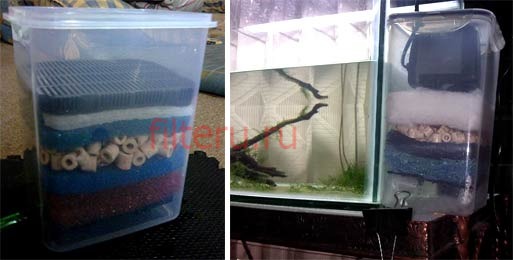
VIDEO OPTION 2
Internal filters have a simplified structure, so making them with your own hands will not be difficult even for an inexperienced aquarist.
For making an internal filter for an aquarium required:
- a plastic bottle, for example, soda, with a volume of 0.5 liters,
- a piece of padding polyester,
- a plastic tube that matches the diameter of the neck,
- pebbles for filler,
- hose and compressor.
VIDEO ON TOPIC
- The bottle must be divided into two parts, but so that one is smaller than the other. The smaller part should remain with the neck. The bowl must be directed upwards with the neck and with force, so that the structure is tight.
- Then along the outer circumference it is necessary to make holes for the flow of water. Their diameter should be about 3-4 mm, it is better to place them in two rows of 6 holes each.
- Next, you need to insert a pipe into the neck of the bowl. In this case, no gaps should be left between the neck and the pipe.
- The tube should be long enough to protrude slightly above the surface. But the structure itself should not lie at the bottom, so as not to impede the flow of water.
- On top of the bowl, you need to fill in a layer of gravel, and then a layer of padding polyester. Next, a hose must be installed in the tube and secured. This structure must be placed in the aquarium. After the compressor turns on, the device will start working. After some time, live bacteria will appear in the device, which are necessary for the dissolution of ammonia into nitrates.
The principle of operation of the filtering device is as follows: it is completely based on an airlift. Air bubbles enter the tube and then move upward and pull water flows.
Oxygenated water enters the upper layers through the gravel, then moves down through the holes made and goes through the tube into the aquarium. The cleaning task is performed by a synthetic winterizer, it will help the gravel not to silt up.
Let's consider several options for bottom filters that are suitable for small aquariums with a volume of up to hundreds of liters. You can also make according to these schemes. bottom filter for round aquarium.
Bottom filter made of plastic box
The role of the device body will be played by a sturdy plastic box with a lid that tightly closes the box from above. In this case, it is desirable that either the body itself or the lid are clearly visible so that the level of contamination can be monitored.
A plastic tube must be glued into the cover. It is necessary to make several holes on the side wall, but such that through them small inhabitants of the aquarium are not sucked into the filter.
Inside the case, you need to place a pre-prepared filler for water filtration. It is recommended to use a ceramic sprayer for water; it will not be difficult to buy it in a store.
Glass jar bottom filter
An ordinary glass jar with a volume of up to 1 liter will be used as a body for the future design. It needs to be closed tightly plastic cover and make a hole in it so that water flows inside, as well as a hole for the tube.
From one more cover it is necessary to make a partition and lay the filter material.
A glass jar can be replaced by a ceramic vessel filled with quartz sand and nylon threads.


